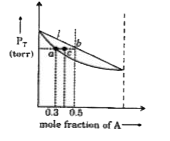Ferrous oxide has a cubic structure and each edge of the unit cell is 5.0 Å. Assuming density of the oxide as 4.0gcm−3, then the number of Fe2+andO2− ions present in each unit cell will beSolution in Malayalam
Four Fe2+and four O2−
Two Fe2+ and four O2−
Four Fe2+ and two O2−
Three Fe2+ and three O2−
The correct Answer is:A
Let the units of ferrous oxide in a unit cell=n, mol. Wt. of ferrous oxide=56+6=72 g mol−1
Wt. of n units=72×n6.023×1023, Vol. of one unit cell=(length of edge)3=(5A∘)3=125×10−24cm3
Density=wt. of cellvolume,4.0=72×n6.023×1023×125×10−24
n=3011.5×10−172=41.8×10−1=4.18≈4.
Topper's Solved these Questions
- BOOK - BRILLIANT PUBLICATIONCHAPTER - SOLID STATEEXERCISE - LEVEL-310videos
SOLID STATE
- BOOK - BRILLIANT PUBLICATIONCHAPTER - SOLID STATEEXERCISE - LEVEL-3 (Multiple Correct Answer Type)13videos
SOLID STATE
- BOOK - BRILLIANT PUBLICATIONCHAPTER - SOLID STATEEXERCISE - LEVEL-150videos
SOLID STATE
- BOOK - BRILLIANT PUBLICATIONCHAPTER - REDOX REACTION & ELECTROCHEMISTRYEXERCISE - QUESTION (ELECTROCHEMISTRY) (LEVEL -II) (ASSERTION-REASON)3videos
REDOX REACTION & ELECTROCHEMISTRY
- BOOK - BRILLIANT PUBLICATIONCHAPTER - SOLUTIONSEXERCISE - Level-III (Linked Comprehension Type)12videos
SOLUTIONS
Similar Questions
The unit cell length of NaCl is observed to be 0.5627 nm by X-ray diffraction studies, the measured density of NaCl is 2.164 g cm−3. Calculate % of missing Na+andCl− ions.
View SolutionWhich of the following statements are correct ?
03:26View SolutionThe radius of a di val ent cation M2+ is 94 pm and of divalent anion X2− is 146 pm. Thus, M2X2− has
03:38View SolutionAssertion: After the electrolysis of aqueous CuSO4 solution pH decreases.
Reason: Sulphuric acid is formed.03:26View Solution1 mole of A and 1 mole B are mixed together to form an ideal solution at 25∘C. Solution is placed in a vessel fitted with piston. If pressure on the solution is reduced isothermally.

Correct relationship between P∘AandP∘B is03:45View Solutionfemous oxide has cubes structure and each edgeof the unit cell is 5.0 Å .Assuming of the oxide as 4.0g//cm^(3) then the number of Fe^(2+) and O^(2) inos present in each unit cell will be
02:21View SolutionFerrous oxide has cubes structure and each edge of the unit cell is 5.0Å .Assuming of the oxide as 4.0g/cm3 then the number of Fe2+andO2 inos present in each unit cell will be
View SolutionFeO crystal has a simple cubic structure and each edge of the unit cell is 5A∘. Taking density of crystal as 5gm/cc the number of Fe2+ and O2− ions present in each unit cell are:
03:52View SolutionFerrous oxide (FeO) crystal has a cubic structure and each edge of the unit cell is 5.0 A^(@) Taking density of the oxide as 4.0gcm^(-3) . The number of Fe^(2+) and O^(2-) ions present in each unit cell is:
02:07View SolutionFerrous oxide has a cubie structure and edge length of the uint cell is 5.0Å . Assuming the density o ferrous oxide to be 3.84 g//cm^(3) , the no. Of Fe^(2+) and O^(2-) ions present in each unit cell be : (use N_(A)= 6xx 10^(23) ):
02:48View SolutionIron (II) oxide has a cubic structure and each unit cell has side 5 Å. If the density of the oxide is 4 g cm^(-3) , the number of oxide ions present in each unit cell is (Molar mass of FeO = 72 "g mol"^(-1) , N_A=6.02xx10^23 mol^(-1) )
View Solutionफेरस ऑक्साइड की संरचना सरल घनीय है और इसके एकक सेल का प्रत्येक किनारा 5.0 Å है। इस ऑक्साइड का घनत्व 4.0 ग्राम सेमी−3 मानकर Fe2+ और O2−आयनों की संख्या प्रत्येक एकक सेल में होगी
View Solutionआयरन (II) ऑक्साइड की घनीय संरचना है तथा इसके कोर की लम्बाई 5Å है । यदि ऑक्साइड का घनत्व 4 ग्राम "सेमी"^(-3) हो तो प्रत्येक इकाई सेल में उपस्थित Fe2+ तथा O2− आयनो की संख्या ज्ञात कीजिए । (FeO का आण्विक द्रव्यमान = 72)
03:33View SolutionFerrous oxide has a cubic structure and eged length of the unit cell is 5.0 A. Assuming the density of ferrous oxide to be 3.84g//cm^(3) the no. of Fe^(2+) and O^(-2) ions present in each unit cell are ("use "N_(A) = 6 xx 10^(23))
05:27View SolutionFerrous oxide has a cubie structure and edge length of the uint cell is 5.0Å . Assuming the density o ferrous oxide to be 3.84g/cm3 , the no. Of Fe2+ and O2− ions present in each unit cell be : (use NA=6×1023):
04:12View SolutionFeO crystal has a simple cubic structure and each edge of the unit cell is 5 Å . Taking density of the oxide as 4g/cc, the number of Fe^(2+) and O^(2-) ions present in each unit cell are
03:49View Solution

